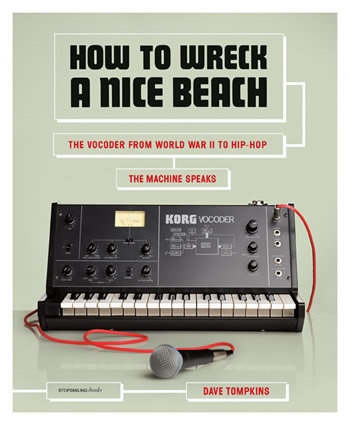 Aisles
Aisles
Life Story of the
Robot Voice
How to Wreck a Nice Beach: The Vocoder from World War II to Hip-Hop
by Dave Tompkins
Review by Lucas Bernhardt
 he vocoder, which once took up whole floors in urban centers and now can be carried around in one’s pocket without displacing keys and wallet, is a versatile gizmo, capable of compressing and altering voices and other audio. In Hollywood, hip-hop, and in the popular imagination, the vocoder is the thing that makes human voices robotic. David Tompkins’s new history of the vocoder, How To Wreck A Nice Beach, lets the robot free associate, at first about its youth serving on various fronts in World War II, and then, after the passage of four decades and countless theories of identity, its emergence as an 80s pop star.
he vocoder, which once took up whole floors in urban centers and now can be carried around in one’s pocket without displacing keys and wallet, is a versatile gizmo, capable of compressing and altering voices and other audio. In Hollywood, hip-hop, and in the popular imagination, the vocoder is the thing that makes human voices robotic. David Tompkins’s new history of the vocoder, How To Wreck A Nice Beach, lets the robot free associate, at first about its youth serving on various fronts in World War II, and then, after the passage of four decades and countless theories of identity, its emergence as an 80s pop star.
Ostensibly, Tompkins has written the vocoder’s life story, from its invention in 1928, through years of scrambling and unscrambling phone calls between Churchill and Roosevelt, JFK and Harold McMillan, to its heyday turning vocalists into cyborgs and blenders on electronica albums. “Story,” in this case, may be a misleading term, as the cameos the device makes throughout musical and military history, not to mention its current ubiquity as a cell phone component, are something other than coherent. But it is to Tompkins’s credit that he shows the reader so many of the tentacles of this bit of technological virtuosity without caricaturing the monster.
The book progresses in tense leaps, explaining, “Something had to protect Stalin’s busy imagination from itself” in one breath, and in the next mentioning that in 1984, Stevie Wonder’s keyboard tech sang the “Song of the Volga Boatman” through a vocoder. Reflecting the way a technology infests the world as much as it is invented, developed, and adapted—the approach has its merits. Tompkins also builds his own experiences into the narrative. Anecdotes about growing up a fan of vocoder music, chasing down sources for the book, and thinking through unexpected connections between disparate characters and themes help situate the reader between leaps. Like the pioneers of vocoder music and the most readable pop-culture critics of our time, Tompkins seems to enjoy both his subject matter and the sound of his own writing:
To the generation that discovers these conspiracies on the Internet, “Clear” would be recognized for what it isn’t, something Missy Elliott sampled for her 2002 single “Lose Control.” The conceit was simple: Music makes you hallucinate blue Lamborghinis airbrushed by Ciara chorus while Fat Man Scoop, the drill sergeant of hype men, berates the freaks, freaking the club. It’s all seizures and tracksuits, boneless and acrylic.
In the way certain animals will line their nests with most anything they can carry off, so people, it seems, will press most any sound bite or gadget into the service of warfare or self-expression. In How To Wreck, however, real distinctions are made between those interested in the vocoder’s potential for improving national security, those who saw it as a mask behind which they could tell the truth or cook up involved artistic misdirections, and those for whom it was just another recording studio toy. Everyone knows that developing individual characters is one way of bringing the imponderable, like an era or the Second World War, into a tentative focus, but it can also go a long way towards revealing the attraction of other people’s music.
If you’ve ever been handed a mixed tape and told, “This is going to destroy your ridiculous fucking world,” you probably know the disappointment of walking away from the stereo with said world intact. Reading the tragic deaths of Larry and Roger Troutman, Rick Davis’s struggles with PTSD, and Rommelzee’s household routines provides at least enough context to make you want to give that funk/electro/hip-hop mix another listen. These and other hors d’oeuvres are set out with the knowledge that, for the vast majority of readers, the real banquet is waiting nearby on YouTube.
Chapter by chapter and episode by episode, “How To Wreck” is forever passing the baton to the reader. Just how fast and how far anyone wants to carry it is each reader’s own business, but the skill and enthusiasm of the handoff are something.
 Lucas Bernhardt is a managing editor at the magazine.
Lucas Bernhardt is a managing editor at the magazine.


